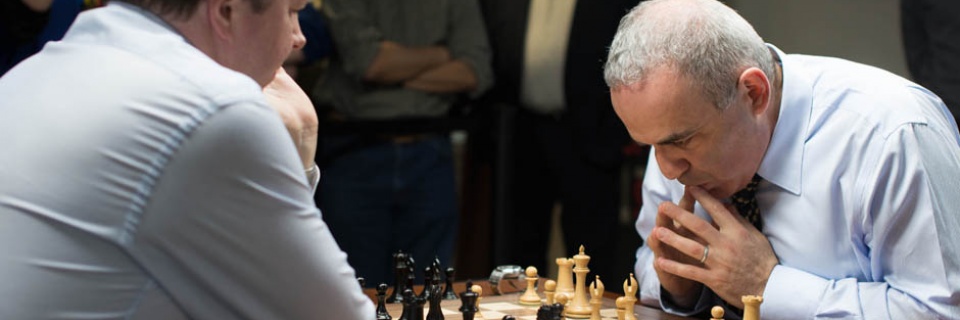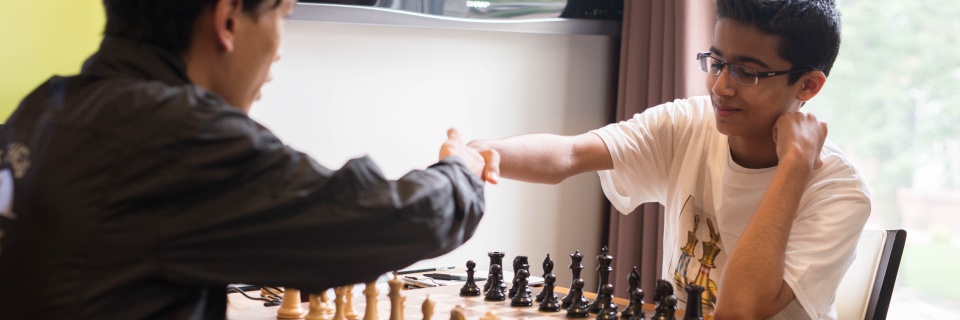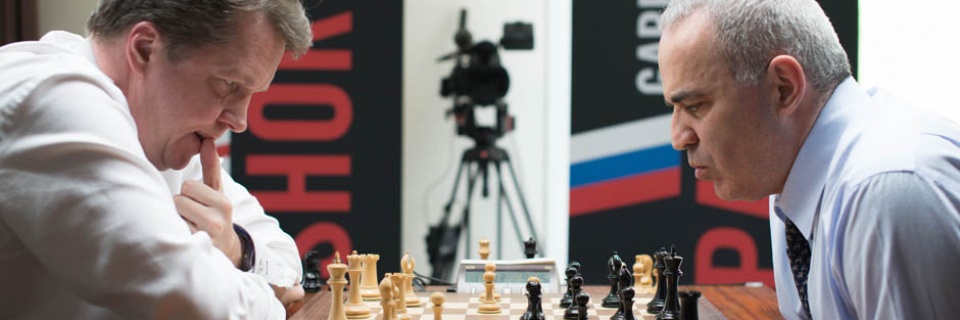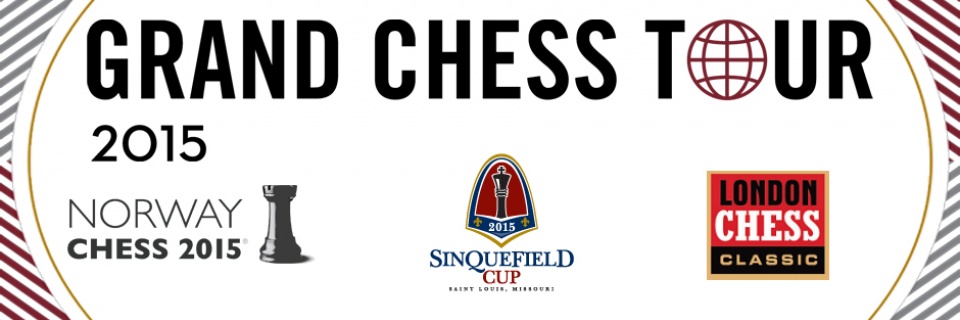2012 U.S. Championships News
Written and analyzed by GM Mackenzie Molner. Photos taken by Austin Fuller.
Yian Liou vx. Akshat Chandra (Game of the Day)
Certainly the game of the day! Liou went into the game today in a tie for second place and Chandra in first place. Both players have been playing their top game since the beginning of the tournament. When leaders of a tournament play each other, one of the two players will often play an opening move that is close to vest and not take any chances to upset the tournament situation. The opposite was true today! The players began the game in aggressive fashion with yet another Najdorf Sicilian.
Surely enough, in accordance with games of previous rounds, White chose to combat the Najdorf with another variation featuring the aggressive and thematic move g4. Liou played the opening quickly and in a slightly unorthodox fashion. Liou combined several slow, preparatory moves like 7. Be2 and 9. a3, with an aggressive approach based on a kingside pawn storm. This unorthodox combination of plans allowed Chandra to emerge from the opening with a slight advantage. Despite Black having the preferable chances, White’s position remained solid, and with opposite side castling, all three results were possible.
By move 20 an interesting situation had occurred on the board. On the surface, both players looked posed to start an attack against their opponent’s king but there was no clear sign of either player making progress. Due to the difficulty in starting an attack, both players began a series of maneuvers looking to improve their positions. The maneuvers soon resulted in several exchanges, reaching a watered-down version of an opposite side castling position.The players still continued with the standard pawn storms but due to the reduced material, there was no longer a serious threat of checkmate. The position was balanced, and after further simplifications, Liou and Chandra agreed to a draw on move 32.
Ruifeng Li vs. Luke Harmon-Vellotti
Today, we saw an opening that Luke Harmon-Vellotti specializes in: the French Defense. The French has a very combative reputation, but the variation featured in the game led to a quiet, more positionally oriented struggle. Although Luke’s combination of f6 and h6 in the middlegame didn’t impress the commentators, no serious damage was done. Slowly, Black’s position improved and, eventually, held a classic bishop-pair advantage. Ruifeng defended well and was able to reach a drawn, pawn down, opposite colored bishop endgame. The players quickly agreed to a draw.
Jeffrey Xiong vs. Arthur Shen
Both players came into this game sitting on an even score, although they had both gotten to this score in very different ways. Xiong started the tournament with two very solid draws, while Shen was involved in two wild Najdorf Sicilians full of exciting, attacking chess. The game followed the trend from Shen’s previous games and featured Shen’s third Najdorf Sicilian of the tournament. Shen fared better than his previous effort with Black and, at one point, held a large advantage. As the game approached the second time control, the position was extremely complicated. Xiong was able to make the most of the position’s tactical opportunities, emerging with a winning advantage going into the second time control. Jeffery quickly converted his advantage. The win should give him a big boost, gaining ground on the tournament leaders.
Awonder Liang vs. Michael Bodek
 Bodek trusted in his favorite defense against 1.e4, the Sicilian Dragon. This was a bit of a surprise from Awonder Liang considering that in his first game with the White pieces he began with 1. d4. Awonder proved that he had done his homework and revealed in the postgame interview that he was still in preparation by move 17. His preparation did him wonders (no pun intended), because by the time he was thinking on his own, he already had a significant advantage. Bodek was able to bring the game close to equality on move 25 but Liang’s material advantage eventually proved too much to handle. Awonder is off to a fantastic start with 2.5/3 and a share of the lead!
Bodek trusted in his favorite defense against 1.e4, the Sicilian Dragon. This was a bit of a surprise from Awonder Liang considering that in his first game with the White pieces he began with 1. d4. Awonder proved that he had done his homework and revealed in the postgame interview that he was still in preparation by move 17. His preparation did him wonders (no pun intended), because by the time he was thinking on his own, he already had a significant advantage. Bodek was able to bring the game close to equality on move 25 but Liang’s material advantage eventually proved too much to handle. Awonder is off to a fantastic start with 2.5/3 and a share of the lead!
Curran Han vs. Mika Brattain
Unfortunately for Han, he came into the game today with 0/2. From the start, it appeared his struggles were likely continue. Brattain remained true to his solid play early on in the game, avoiding a complicated, but potentially promising, piece sacrifice on move 12. Brattain could have played the well-known trojan horse bishop sacrifice Bxh2+ leading to complicated play. Han outplayed his opponent in the middlegame, earning an advantage which soon fizzled out. With almost no play left in the position, the players agreed to a draw.
Written and analyzed by GM Mackenzie Molner. Photos taken by Austin Fuller.
Arthur Shen vs. Ruifeng Li (Game of the Day)
With the White pieces today, Arthur Shen was looking to make it back to an even score after a tough loss in the first round. Li, who is usually a Sicilian player, chose to combat 1. e4 with the Najdorf Sicilian. Shen chose a very combative opening variation beginning with 6. h3, preparing a quick kingside pawn storm. Interestingly, it was this very same strategy that proved too tough to deal with for Shen when he played the Black side of the same opening in round one. The game had all the characteristics of a sharp battle right from the beginning with the opposite side castling and pawn storms heading for the kings.
Often in very sharp games such as this, the first inaccurate move can lead to a very difficult position due to the high stake nature of the game. This is exactly what happened on move 14 when Black played Nc4. The slow maneuvering it took to get the knight to this square proved to be too big of a loss of time. This allowed Shen’s strong response 15. Bxc4! which caused a change in the pawn structure and lessening Black’s attacking chances. 14… Nxd4 was needed in order to maintain Black’s fair share of counter chances. Black’s position would remain flexible - with a chance to pawn storm or use the c-file for counterplay. White’s dangerous attacking chances soon transformed into a material advantage which Shen took into a winning, 2 pawn up endgame. Shen converted his advantage in good style. He slowly improved his position while keeping his opponent’s pieces tied down to Black’s weaknesses.
Another hard fought game which has become the norm at the U.S. Junior Closed Championships! Shen’s games from both round one and two show how effective the kingside pawn storm can be in the Sicilian. As a fan of the Sicilian, I hope that we will see Black strike back soon!
Awonder Liang vs. Mika Brattain
 In the past, Awonder Liang has played some daring defenses against 1. d4, such as the King’s Indian. Today Liang started the game in a more solid style: opting for the Ragozin defense. Liang’s 8… Be7 looked uncharacteristic of the Ragozin, and it appeared that White would have decent chances to gain an opening advantage. Brattain was unable to obtain any tangible advantage but maintained a lead on the clock, which would later prove important. The game remained relatively equal until time trouble began to make its’ presence felt. By the time the dust settled from the first time control, Brattain had earned himself a nagging endgame advantage. Despite showing strong technique for a large portion of the endgame, Brattain had to eventually settle for a draw
In the past, Awonder Liang has played some daring defenses against 1. d4, such as the King’s Indian. Today Liang started the game in a more solid style: opting for the Ragozin defense. Liang’s 8… Be7 looked uncharacteristic of the Ragozin, and it appeared that White would have decent chances to gain an opening advantage. Brattain was unable to obtain any tangible advantage but maintained a lead on the clock, which would later prove important. The game remained relatively equal until time trouble began to make its’ presence felt. By the time the dust settled from the first time control, Brattain had earned himself a nagging endgame advantage. Despite showing strong technique for a large portion of the endgame, Brattain had to eventually settle for a draw
Jeffrey Xiong vs. Michael Bodek
Before the game, this was my pick for the most exciting game of the round. Halfway through the round, I realized that the opposite was likely to be true. Unfortunately for the spectators, the opening played in the game had a drawish reputation. Both sides played very accurately throughout the entire game, eventually reaching a symmetrical endgame that was agreed drawn on move 30. A short but high quality game.
Curran Han vs. Akshat Chandra
In round one, Chandra won on the Black side of the Grunfeld defense against one of the highest rated players in the tournament, Luke Harmon-Vellotti. Today, the tables were turned and he was on the opposite side of the same opening. Curran was in a difficult situation, getting Black for the second time in a row, against a player fresh off of a confidence-boosting win. Chandra’s 5. Bd2 was recently featured in the World Championship match between Carlsen and Anand. Chandra continued on with his good form from round one and slowly turned a small positional advantage into the full point.
Yian Liou vs. Luke Harmon-Vellotti
 In round one, Harmon-Vellotti lost with the White pieces against Chandra’s Grunfeld defense. Yian Liou on the other hand, was off to a great start, with a round one victory over Arthur Shen. Harmon-Vellotti tried his luck with 1. e4 today opposed to his first round choice of 1. d4. He faced a former favorite of Magnus Carlsen, and one of Black’s most solid responses to 1.e4, the Breyer variation of the Ruy Lopez. Many of the variations of the Ruy Lopez tend to lead to closed positions, with lots of maneuvering. Vellotti chose not to close the position but this allowed Liou a chance to open up the game favorably for the Black pieces, with 17… exd4! Black generated a strong initiative which soon turned into a decisive advantage. The size of Black’s advantage varied throughout the rest of the game. Luke Harmon-Vellotti was finally able to bail out into a worse, but theoretically drawn endgame. Finally, after more than 120 moves Luke was able to secure the draw. Liou found out why his opponent has a nickname here in St. Louis of Lucky Luke.
In round one, Harmon-Vellotti lost with the White pieces against Chandra’s Grunfeld defense. Yian Liou on the other hand, was off to a great start, with a round one victory over Arthur Shen. Harmon-Vellotti tried his luck with 1. e4 today opposed to his first round choice of 1. d4. He faced a former favorite of Magnus Carlsen, and one of Black’s most solid responses to 1.e4, the Breyer variation of the Ruy Lopez. Many of the variations of the Ruy Lopez tend to lead to closed positions, with lots of maneuvering. Vellotti chose not to close the position but this allowed Liou a chance to open up the game favorably for the Black pieces, with 17… exd4! Black generated a strong initiative which soon turned into a decisive advantage. The size of Black’s advantage varied throughout the rest of the game. Luke Harmon-Vellotti was finally able to bail out into a worse, but theoretically drawn endgame. Finally, after more than 120 moves Luke was able to secure the draw. Liou found out why his opponent has a nickname here in St. Louis of Lucky Luke.
Written and analyzed by GM Mackenzie Molner. Photos taken by Austin Fuller.
Luke Harmon-Vellotti vs. Akshat Chandra (Game of the Day)
Two of the highest rated players, and potential favorites in the tournament, were tasked to face-off right off the bat during the first round matches. The game began in a slightly offbeat line of the Grunfeld Defense that is a pet line of Harmon-Vellotti. I know personally that he has plenty of experience with this line, because he beat me with it last year! Harmon-Vellotti has even played this tactic before in the 2014 U.S. Junior Closed, in the match against Jeffery Xiong.
This particular line from White is often played to avoid a lot of the sharp, complex, and lengthy variations of the Grunfeld, with the option for White to play a simplified endgame. Harmon-Vellotti prefers to keep the game in very combative territory by sacrificing a pawn with his move 6. Bh4. 6. Bf4 would be the more dull alternative, which usually leads to a peaceful endgame. White’s pawn sacrifice leaves him a nice pawn center and more active pieces, but the strength of the extra pawn shouldn’t be underestimated in the long-term.
Black is the first one to err, with the move 11… Bb7. On the surface, this looks like a standard developing move. It protects the rook on a8 while developing, however, the bishop’s placement isn’t improved much on b7. It has no new active possibilities. 11… Nd7 would be a better way to combine Black’s intentions of protecting the a8-rook while also developing. Black on the next turn will play Nb6, placing the knight on a great square, from which it still has chances to improve, with possible jumps into a4 or d5. On b6 it also keeps an eye on the rook on a8. Black will be able to develop the light-squared bishop to a more active square, like e6 or f5, achieving very harmonious development.. White’s best way to try to take advantage of this was the move 12. Qb1. It threatens the immediate Bxc4, which would instantly regain the pawn due to the pin on the b7-bishop, as well as looking to play Qb4, preventing Black from castling.
The game tensely continued until move 19, when it was White who went wrong. White played 19. Rfb1 which seems to improve White’s last piece left out of play. It turns out that it’s still not active enough, allowing the strong response, 19… e4 which is exactly what Chandra plays in the game. Chandra earned a strong initiative which he never let go of. Despite Black castling as late as move 26(!) it was White’s King who faced major troubles. Chandra played a series of strong attacking moves beginning with 27… Bg3, trading off White’s only kingside defender, allowing Black’s pieces to quickly circle the White King. Black’s 31st move fxg4, signaled the end for white, with Black now introducing two new attackers on White’s King, the f8-rook and the g4-pawn, which would play an important role in creating a mating net. With the attacking count to 3 pieces versus no defensive pieces, there was little that White could do.
In a very difficult position, Velotti made his final mistake with 34. Qh6. Although there was no sufficient defensive solution, Qg1 instead would force Black to demonstrate accuracy before winning the game. Chandra brought the last piece into the attack with 35...Rbf7! White resigned due to Black’s unstoppable threats of Qxg1 or Rf5. An impressive and hard-fought struggle from both players led to a great way to kick off the championship!
IM Luke Harmon-Vellotti v. IM Akshat Chandra, Round 1 // Annotation by GM Mackenzie Molner
Yian Liou vs. Arthur Shen
 Perhaps the most surprising game of the round. Liou played the opening in very convincing and aggressive style with a nice novelty 12...c3, improving over games played by players even as strong as Topalov! Black’s response 12…b5 is a completely standard move in the Najdorf but left Black’s position overextended on the queenside. White played the middlegame very precisely. By ruthlessly undermining Black’s queenside pawn structure, he achieved a decisive advantage that he exploited smoothly.
Perhaps the most surprising game of the round. Liou played the opening in very convincing and aggressive style with a nice novelty 12...c3, improving over games played by players even as strong as Topalov! Black’s response 12…b5 is a completely standard move in the Najdorf but left Black’s position overextended on the queenside. White played the middlegame very precisely. By ruthlessly undermining Black’s queenside pawn structure, he achieved a decisive advantage that he exploited smoothly.
Ruifeng Li vs. Michael Bodek
 Li starts out the game with quick and confident moves on the White side of the Dragon, that seem to indicate that he was in his preparation deep into the opening. He could have made the most of this preparation with the move 17. Rb5! This would have held White’s extra pawn, along with a healthy advantage. Instead he played 17. Bd4 which passed the initiative over to Black. Bodek brilliantly seized his chance with a temporary piece sacrifice earning a significant endgame advantage. Bodek held onto a large advantage until 32… f5?. Although Black was still better, Li defended stubbornly and made the draw on move 47.
Li starts out the game with quick and confident moves on the White side of the Dragon, that seem to indicate that he was in his preparation deep into the opening. He could have made the most of this preparation with the move 17. Rb5! This would have held White’s extra pawn, along with a healthy advantage. Instead he played 17. Bd4 which passed the initiative over to Black. Bodek brilliantly seized his chance with a temporary piece sacrifice earning a significant endgame advantage. Bodek held onto a large advantage until 32… f5?. Although Black was still better, Li defended stubbornly and made the draw on move 47.
Jeffrey Xiong vs. Mika Brittain
 Xiong comes into the game as the highest rated player in the tournament and, after winning the Chicago Open, must be the favorite to win the event. After achieving a pleasant opening advantage, Xiong faced stiff resistance in the middlegame and the position quickly went from pleasant for White to dead equal. The game was soon drawn, with the players shaking hands on move 32.
Xiong comes into the game as the highest rated player in the tournament and, after winning the Chicago Open, must be the favorite to win the event. After achieving a pleasant opening advantage, Xiong faced stiff resistance in the middlegame and the position quickly went from pleasant for White to dead equal. The game was soon drawn, with the players shaking hands on move 32.
Awonder Liang vs. Curran (Ray) Han
 Liang came into the game with a sizable rating advantage. The game started out as a Samisch King’s Indian which has an aggressive reputation for White. Despite the aggressive nature of the variation, the queens were traded off by move 11. The position was approximately equal but Liang slowly outplayed his opponent in a positional fashion that shows a level of maturity not normally seen from players of his age. Can put up sturdy resistance but Liang kept up the pressure until he won on move 44.
Liang came into the game with a sizable rating advantage. The game started out as a Samisch King’s Indian which has an aggressive reputation for White. Despite the aggressive nature of the variation, the queens were traded off by move 11. The position was approximately equal but Liang slowly outplayed his opponent in a positional fashion that shows a level of maturity not normally seen from players of his age. Can put up sturdy resistance but Liang kept up the pressure until he won on move 44.
By Brian Jerauld
Kasparov, defending with his trademark Najdorf Sicilian, was too strong for Short in Rapid Round 2 // Austin Fuller photo
And just like that, Garry Kasparov has left the building.
Though his appearance was brief, returning to the board for only two days and 10 games in his Battle of the Legends match against Nigel Short, while he was here Kasparov made certain to leave nothing on the table.
No missed opportunities. Not many of Short’s pieces. And certainly, no doubt.
Convincing enough on Saturday, emerging from the first day with a two-point lead, Kasparov reminded the world who he is on Sunday at the Chess Club and Scholastic Center of Saint Louis. Though retired for a decade, the greatest chess player in history completely dismantled Short -- still active, as the world’s No. 60 player -- with a stunning 5-0 sweep of the afternoon. The brutal end of the lopsided 8.5-1.5 match, which featured him flagging for a loss on day one to raise concerns about rust collecting on the 13th World Champion of Chess, instead reminded everyone: Gold does not rust.
“I feel great, and I have to confess: I'm also surprised,” Kasparov said of his toppling victory. “I felt like it was time to play as I had played 20 or 30 years ago: Just have fun -- and attack, attack. So I did it in every game, and it worked.”
Indeed, at 52 years old on Sunday, Kasparov looked like the player of yesteryear, showcasing five games worth of devastating attacks that left the bout looking less like a mismatch, and more like he was simply running up the score. Ironically Sunday’s first game -- the day’s only to feature a longer Rapid time control -- was the only game to reach a fantastic race in time pressure, while the remaining four Blitz games featured lopsided crushes, each of them worse than the last.
“I think I had chances in that first game -- and then things started to go from bad to worse,”Short said. “By the last game, I didn't see anything at all. I didn’t see a single move."
The only points Short earned came in Day 1. His only victory came when Kasparov flagged in Blitz Round 2 // Austin Fuller photo
Sunday’s opening Rapid game was a nostalgic chess fan’s delight, as Kasparov with the black pieces defended in his trademark Najdorf Sicilian. His lash out with 13...h4...h5 helped to tear open white’s kingside protection, while his exchange sacrifice at 16...Rxc3 collapsed the center and ravaged white’s pawn structure.
Through a middlegame with variations plentiful and wild, Short held the material advantage extremely well, using the recapture at 21. cxd5 to repair his structure and temporarily hold black’s compensation attack at bay. The move left Kasparov stalled, head shaking in frustration as his clock fell below six minutes, and finally deciding on the innocuous 22...a5. Short responded with a quick 23. Rc1, further solidifying his position.
If there were any questions about Kasparov's form in Day 1, classic Kasparov showed up for Day 2 to put them all to rest // Austin Fuller photo
But Short gave up a nearly five minute clock advantage before deciding on 24. Qb3, and his 26. f4! triggered the blitz fireworks in a fantastically complex endgame.
GM Nigel Short v. GM Garry Kasparov, Rapid Round 2 // Annotation by GM Alejandro Ramirez
After collapsing in the rapid Rapid endgame, Short was rolled over with each of the four passing Blitz games.
“Unfortunately, chess is a sport, and you need energy -- and that’s what was completely lacking in my own game,” said Short, who won the Thailand Open last week but reported a suffering from jet lag in Saint Louis. “Actually, I felt my energy going down throughout this match. I just didn’t arrive in good physical condition."
In Sunday’s second Blitz game, Short steered clear of more Kasparov Najdorf hijinx, the game turning into a Classic Sicilian. By 13...Qa5, Kasparov was on the attack again, shocking Short with a quickly played 15...e4 that sent white’s army into disarray.
GM Nigel Short v. GM Garry Kasparov, Blitz Round 6 // Annotation by GM Alejandro Ramirez
Short was all-but looking for the exit by the match’s tenth and final game, body language indicating that he had seen better days. He desperately tried to slow the afternoon onslaught down into a positional battle, but Kasparov continued to pour it on. Black’s castling on the 14th move allowed white the central break with 15. e4, but Kasparov’s response of 15...c5 turned the game on a sharper blade and rocked Short back in his seat.
Under kingside duress already, Short sent his queen away hunting pawns with 24. Qxd5+, while Kasparov’s queen slipped in through the back door. The legend brought the match to a close with a menacing attack, ending the vicious afternoon with a fitting finish: Checkmate on the board.
GM Nigel Short v. GM Garry Kasparov, Blitz Round 8 // Annotation by GM Alejandro Ramirez
“He’s the greatest player in chess history, in my opinion,” Short said. “He had a much longer reign than Bobby Fischer -- Bobby probably burned brighter for a shorter period of time, but Garry just kept on winning and winning for many, many years.”
By Brian Jerauld
All eyes on the 1993 World Championship rematch of Kasparov v. Short, both playing in Saint Louis for the first time // Austin Fuller photo
Those pursed lips. The extended chin. That familiar furrowed brow.
All of this recognizable before the clocks had even started.
After 10 long years of retirement, the 13th World Champion of Chess, Garry Kasparov, returned to his old black-and-white stomping grounds Saturday afternoon -- reappearing with a style so familiar, one could question if he had left the game only yesterday. At the Chess Club and Scholastic Center of Saint Louis, Kasparov took sides for only the fourth time since 2005, re-emerging for the Battle of the Legends match against his famous foe-turned-friend counterpart, famed English Grandmaster Nigel Short.
Dueling through one Rapid game of chess followed by four Blitz contests, Kasparov fell right back into his animated groove of play -- tossing cursory glances into the air, then feverishly pressing his face through his hands -- and to the fans’ delight, returning to his memorable aggression on the board. Kasparov took a 3.5-1.5 lead over Short in the two-day, ten-game Battle of the Legends match, first settling with a wonderfully fought draw in the Rapid control, then smashing through with victories in three of the four Blitz.
“It’s easy for me to play the sharp game, where I see the straight lines,” Kasparov said. “But when you’re out of practice, it is extremely difficult to play a slow maneuvering game. Nigel was right dragging me into positions where the lack of practice helps -- and you could see that in game three.”

Kasparov returns to form during the fast-paced Blitz play, earning a 3.5-1.5 lead halfway through the inuagural Battle of the Legends // Austin Fuller photo
That third game, the second Blitz contest of the afternoon, revealed perhaps the only sign of rust given from Kasparov’s retirement: forgetting about his old, ticking friend. Intensely focused on seeing through a balanced position, Kasparov seemingly ignored his dwindling clock -- later revealing he felt “disconnected” from it -- and let his final seconds run out to provide Short his only win of the day. Kasparov rebounded with two victories to close the afternoon, however, including the day’s only win with the white pieces in Game 5.
“To be honest, I’ve never played with a delay in my life -- never, in any sort of important game,” Short said of the 5-minute, 3-second delay Blitz time control. “I haven’t quite got the hang of that. Also, I tried a little bit to exploit Garry’s lack of practice, put a little bit of clock pressure on him. It was a conscious idea, but I missed a lot of things. I was disappointed.”
For his part, Short defended wonderfully in the match’s opening Rapid round. In a Bogo-Indian, Short’s early 4...c5 slowed Kasparov for a moment of recall, finally deciding on 5. a3 to earn the bishop pair but a delay in development. He worked his way through, however, with the nifty 10. Nb5.
And by 19. Qg3 and 20. f4, the legendary Kasparov was once again on the attack. Short tried to add complications, centralizing with 20...Nd4 and attacking the white rook with 21...Bc4, but Kasparov ignored the attack, accepting the exchange while continuing to peck away at Black’s castle. Short’s clock fell below 7 minutes before finding 23...Kh8 and, worse, his opponent had found a familiar stance: Intently and aggressively leaning across the board.

Kasparov settles into a familiar stance, returning to his old black-and-white stomping grounds for just the fourth time since 2005 // Austin Fuller photo
England’s former child prodigy held his own down the stretch, however, finding all the right moves in a sharp position that required them. He removed white’s menacing white knight by returning the exchange with 24...Rxd5, then confidently played 26...fxe5 to challenge Kasparov’s dangerously forcing back-rank threat. White fully destroyed black’s castle protection, forcing the black king to cower in the corner, but the bishop pair could not help the queen break through black’s last line of defense. With 41. Qd8+, Kasparov entered into threefold repetition.
GM Garry Kasparov v. GM Nigel Short, Rapid Round 1 // Annotations by GM Alejandro Ramirez
Despite applause from the surrounding fans, Kasparov leapt from the board and looked exasperated to not have found the full point.
“People always ask me if I still play,” he said. “I ask them ‘What do you mean by play?’ For me, playing chess is being fully engaged. You find yourself at a chess set, watched by a lot of people not just here in Saint Louis, but worldwide - there is some pressure.”
He looked comfortably fine when he returned to his seat for Saturday’s first Blitz game, delivering a fine attacking victory with the Black pieces out of a symmetrical English. After castling, Short found himself up a pawn but in an extremely unhappy position - worse after giving up his best piece, the white squared bishop with 17. Bxc6. Kasparov revealed his not-subtle intentions with 20...f5 and by 30...Be5, white was ready to collapse under the pressure.
GM Garry Kasparov v. GM Nigel Short, Blitz Round 1 // Annotations by GM Alejandro Ramirez
The final Blitz game of Saturday left the afternoon with a thrilling cap, seeing Short make a last-second error in a queening race and an otherwise book draw. Kasparov as white found himself with a precarious looking position out of the opening, offering a queen trade with 13. Qxf4 that left him with the bishop pair but also a horribly ugly pawn structure.
A pawn exchange on d4 let the lethal bishop pair loose, and Kasparov’s emphasized 24. Rd6 ushered in a nifty exchange on c6 to hurtle toward endgame. Short soon found himself up a pawn, but his lack of control on the position made it seem he was down a full piece -- realized with 44...Nxe7, sacrificing the knight to eliminate white’s impending queening threat
At this point, Kasparov was below 15 seconds on his clock, while Short enjoyed a full minute -- though it was the Englishman who folded in time pressure.
GM Garry Kasparov v. GM Nigel Short, Blitz Round 4 // Annotations by GM Alejandro Ramirez
Sunday afternoon will bring the exciting conclusion to Battle of the Legends: Kasparov vs. Short, with one more Rapid game and four additional Blitz games to begin at 2:00 p.m. CDT. The games can be viewed live on www.uschesschamps.com, with commentary from Grandmasters Maurice Ashley and Alejandro Ramirez set to begin 10 minutes before the first move.
SAINT LOUIS (April 24, 2015) – There is a new, gold standard for international chess competition, providing more opportunities for the world’s best chess players to compete on a grand stage.
The world’s most prestigious, international chess events are combining efforts to establish a gold standard for the inaugural Grand Chess Tour, an annual competitive circuit for ten of the world’s top grandmasters. The announcement was made today at a press conference held at the Chess Club and Scholastic Center of Saint Louis.
The Grand Chess Tour is an affiliation between the Chess Club and Scholastic Center of Saint Louis (Sinquefield Cup), Tower AS (Norway Chess) and Chess Promotions Ltd. (London Chess Classic), combining the organizational efforts of three elite events into one unified competitive structure. The partnership aims to raise worldwide awareness for each prestigious tournament, as well as for the tour.
The inaugural 2015 Tour will kick off in June as a three-event cycle, beginning with Norway Chess 2015, followed by the Sinquefield Cup in August/September, and finishing with the London Chess Classic in December.
| 2015 Grand Chess Tour | Location | Date |
|---|---|---|
| Norway Chess 2015 | Stavanger, Norway | June 15 - 26, 2015 |
| Sinquefield Cup | Saint Louis, USA | August 21 - September 3, 2015 |
| London Chess Classic | London, England | December 3 - 14, 2015 |
Based on FIDE's January 2015 rating list, the Grand Chess Tour invited the world’s top-ten international grandmasters, eight of whom agreed to appear in all three international events. A ninth grandmaster, who will also play the entire tour, will be added at a later date. The tenth and final grandmaster will be selected as a wildcard by each organizing host.
Each of the three 2015 Grand Chess Tour events will award individual prize funds of $300,000, with competitors also tallying points toward a tour prize fund of $150,000; the overall tour champion will receive an additional $75,000. The total prize fund for the circuit is $1,050,000.
- World Chess Champion Magnus Carlsen, Norway
- Fabiano Caruana, Italy
- Alexander Grischuk, Russia
- Veselin Topalov, Bulgaria
- Viswanathan Anand, India
- Levon Aronian, Armenia
- Anish Giri, Netherlands
- Hikaru Nakamura, USA
“The Grand Chess Tour was created with just one goal in mind: Demonstrating the highest level of organization for the world’s best players,” said Tony Rich, Executive Director of the CCSCSL. “Featuring the world’s strongest chess professionals fighting for massive prize funds, along with a full spectator experience led by world-class commentary, this circuit sets forth an internationally coordinated effort that casts a shining spotlight on global chess competition.”
“It’s an honor to be among the giants of chess organizers,” said Joran Aulin-Jansson with Tower AS (Norway Chess). “Having the world’s best chess players in one circuit is a great way to fuel excitement for the future of chess.”
“The London Chess Classic is delighted to be part of this new venture which we feel sure will greatly add to the public interest in top flight chess,” said Malcom Pein, Director London Chess Classic. “We look forward to the Grand Chess Tour climaxing in London and to further tournaments joining the GCT in coming years.”
Participating tournaments are identified as the gold standard for international event organization, setting the model for player conditions, prize funds and spectator experience. Each of the events will cater to live audiences, as well as offer streaming broadcasts complete with grandmaster commentary.
For more information, visit www.grandchesstour.com.








